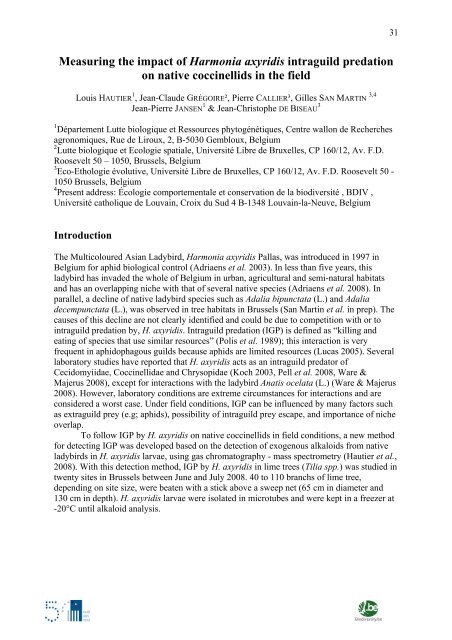Science Facing Aliens - Invasive Alien Species in Belgium - Belgian ...
Science Facing Aliens - Invasive Alien Species in Belgium - Belgian ...
Science Facing Aliens - Invasive Alien Species in Belgium - Belgian ...
Create successful ePaper yourself
Turn your PDF publications into a flip-book with our unique Google optimized e-Paper software.
Measur<strong>in</strong>g the impact of Harmonia axyridis <strong>in</strong>traguild predation<br />
on native cocc<strong>in</strong>ellids <strong>in</strong> the field<br />
Louis HAUTIER 1 , Jean-Claude GRÉGOIRE², Pierre CALLIER³, Gilles SAN MARTIN 3,4<br />
Jean-Pierre JANSEN 1 & Jean-Christophe DE BISEAU 3<br />
1<br />
Département Lutte biologique et Ressources phytogénétiques, Centre wallon de Recherches<br />
agronomiques, Rue de Liroux, 2, B-5030 Gembloux, <strong>Belgium</strong><br />
2<br />
Lutte biologique et Ecologie spatiale, Université Libre de Bruxelles, CP 160/12, Av. F.D.<br />
Roosevelt 50 – 1050, Brussels, <strong>Belgium</strong><br />
3<br />
Eco-Ethologie évolutive, Université Libre de Bruxelles, CP 160/12, Av. F.D. Roosevelt 50 -<br />
1050 Brussels, <strong>Belgium</strong><br />
4<br />
Present address: Écologie comportementale et conservation de la biodiversité , BDIV ,<br />
Université catholique de Louva<strong>in</strong>, Croix du Sud 4 B-1348 Louva<strong>in</strong>-la-Neuve, <strong>Belgium</strong><br />
Introduction<br />
The Multicoloured Asian Ladybird, Harmonia axyridis Pallas, was <strong>in</strong>troduced <strong>in</strong> 1997 <strong>in</strong><br />
<strong>Belgium</strong> for aphid biological control (Adriaens et al. 2003). In less than five years, this<br />
ladybird has <strong>in</strong>vaded the whole of <strong>Belgium</strong> <strong>in</strong> urban, agricultural and semi-natural habitats<br />
and has an overlapp<strong>in</strong>g niche with that of several native species (Adriaens et al. 2008). In<br />
parallel, a decl<strong>in</strong>e of native ladybird species such as Adalia bipunctata (L.) and Adalia<br />
decempunctata (L.), was observed <strong>in</strong> tree habitats <strong>in</strong> Brussels (San Mart<strong>in</strong> et al. <strong>in</strong> prep). The<br />
causes of this decl<strong>in</strong>e are not clearly identified and could be due to competition with or to<br />
<strong>in</strong>traguild predation by, H. axyridis. Intraguild predation (IGP) is def<strong>in</strong>ed as “kill<strong>in</strong>g and<br />
eat<strong>in</strong>g of species that use similar resources” (Polis et al. 1989); this <strong>in</strong>teraction is very<br />
frequent <strong>in</strong> aphidophagous guilds because aphids are limited resources (Lucas 2005). Several<br />
laboratory studies have reported that H. axyridis acts as an <strong>in</strong>traguild predator of<br />
Cecidomyiidae, Cocc<strong>in</strong>ellidae and Chrysopidae (Koch 2003, Pell et al. 2008, Ware &<br />
Majerus 2008), except for <strong>in</strong>teractions with the ladybird Anatis ocelata (L.) (Ware & Majerus<br />
2008). However, laboratory conditions are extreme circumstances for <strong>in</strong>teractions and are<br />
considered a worst case. Under field conditions, IGP can be <strong>in</strong>fluenced by many factors such<br />
as extraguild prey (e.g; aphids), possibility of <strong>in</strong>traguild prey escape, and importance of niche<br />
overlap.<br />
To follow IGP by H. axyridis on native cocc<strong>in</strong>ellids <strong>in</strong> field conditions, a new method<br />
for detect<strong>in</strong>g IGP was developed based on the detection of exogenous alkaloids from native<br />
ladybirds <strong>in</strong> H. axyridis larvae, us<strong>in</strong>g gas chromatography - mass spectrometry (Hautier et al.,<br />
2008). With this detection method, IGP by H. axyridis <strong>in</strong> lime trees (Tilia spp.) was studied <strong>in</strong><br />
twenty sites <strong>in</strong> Brussels between June and July 2008. 40 to 110 branchs of lime tree,<br />
depend<strong>in</strong>g on site size, were beaten with a stick above a sweep net (65 cm <strong>in</strong> diameter and<br />
130 cm <strong>in</strong> depth). H. axyridis larvae were isolated <strong>in</strong> microtubes and were kept <strong>in</strong> a freezer at<br />
-20°C until alkaloid analysis.<br />
31


